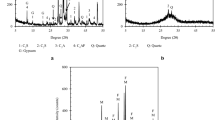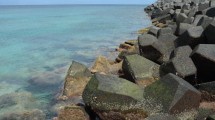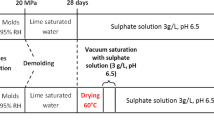Abstract
The durability performance of cementitious material is traditionally based on assessing the effect of a single degradation process. However, this study investigates the coupled deterioration properties of mortar incorporating industrial solid waste—ground granulated blast furnace slag (BFS) and different mineral admixtures, such as calcium sulfate (CS) and limestone powder (LSP). The combined deterioration properties caused by carbonation and frost damage in the mortar sample were experimentally investigated with respect to accelerated carbonation and freeze–thaw tests. Different degrees of deterioration, i.e. after subjected to 12, 30 and 60 freeze–thaw cycles, were induced in the freeze–thaw tests. The experimental investigation of single degradation revealed that the compressive strength, frost resistance and carbonation resistance decrease as the BFS replacement ratio increases by weight from 0 to 45%. The less amount of CH in the BFS cement leads to the carbonation progress more easily. Moreover, to achieve the same strength as ordinary Portland cement, 2 wt% CS and 4 wt% LSP in the BFS mortar are required. However, the data shows that incorporating LSP into the BFS mortar produces a lower frost resistance. The combined damage tests revealed that different deterioration degrees resulting from 12, 30 and 60 freeze–thaw cycles slightly decreased the carbonation resistance, which is related to the decrease in the inkbottle pore volume due to its water retention characteristics. Simultaneously, the pre-carbonation deterioration could effectively decrease the surface mass scaling of the freeze–thaw and the pore structure undergoes densification due to pre-carbonation.











Similar content being viewed by others
Change history
08 November 2017
Due to an unfortunate turn of events, this article was published with an erroneous version of Fig. 9. Please find on this page the correct version of Fig. 9 that should be regarded by the reader as the final version.
References
Zhao J, Cai GC, Zhao S (2014) Influences of freeze–thaw cycle and curing time on chloride ion penetration resistance of Sulphoaluminate cement concrete. Constr Build Mater 53:305–311
Chung CW, Shon CS, Kim YS (2010) Chloride ion diffusivity of fly ash and silica fume concretes exposed to freeze–thaw cycles. Constr Build Mater 24:1739–1745
Gerard B, Marchland J (2000) Influence of cracking on the diffusion properties of cement-based materials: part I: influence of continuous cracks on the steadystate regime. Cem Concr Res 30:37–43
Özbay E, Karahan O, Lachemi M, Hossain K, Atis CD (2012) Dual effectiveness of freezing–thawing and sulfate attack on high-volume slag-incorporated ECC. Composites B 45:1384–1390
Çavdar Ahmet (2014) Investigation of freeze–thaw effects on mechanical properties of fiber reinforced cement mortars. Composites B 58:463–472
Neves R, Sena B, Branco F, De Brito J, Castela A, Montemor MF (2015) Assessing concrete carbonation resistance through air permeability measurements. Constr Build Mater 82:304–309
Parrott LJ (1996) Some effects of cement and curing upon carbonation and reinforcement corrosion in concrete. Mater Struct 29:164–173
Thomas MDA, Shehata MH, Shashiprakash SG, Hopkins DS, Cail K (1999) Use of ternary cementitious systems containing silica fume and fly ash in concrete. Cem Concr Res 29:1207–1214
ACI 213R (2003) Guide for structural lightweight-aggregate concrete. American Concrete Institute, Farmington Hills, p 38
Liu W, Cui HZ, Dong ZJ, Xing F, Zhang HC, Lo Tommy Y (2016) Carbonation of concrete made with dredged marine sand and its effect chloride binding. Constr Build Mater 120:1–9
Zhang P, Zhao T, Jin Z (2008) Influence of freezing and thawing on carbonation of concrete materials. Sichuan Build Sci 34:66–68 (in Chinese)
Mehta PK, Monteiro PJM (2013) Concrete: microstructure, properties, and materials, 4th edn. McGraw-Hill Education, New York City
Leemann A, Moro F (2017) Carbonation of concrete: the role of CO2 concentration, relative humidity and CO2 buffer capacity. Mater Struct. doi:10.1617/s11527-016-0917-2
Cizer O, Navarro CR, Agudo ER, Elsen J, Elsen J, Gemert DV, Balen KV (2012) Phase and morphology evolution of calcium carbonate precipitated by carbonation of hydrated lime. J Mater Sci 47:6151–6165
Chao J, Gu XL et al (2016) Discussion of ‘‘Assessing concrete carbonation resistance through air permeability measurements’’ by R. Neves, Construction and Building Materials 82(2015):304–309. Constr Build Mater 102:913–915
Lim S, Mondal P (2015) Effects of incorporating nanosilica on carbonation of cement paste. J Mater Sci 50:3531–3540
Powers TC (1945) Working hypothesis for further studies of frost resistance of concrete. Am Concr Inst J 16:245
Powers TC, Helmuth RA (1953) Theory of volume changes in hardened Portland-cement pasted during freezing. Highw Res Board 32:285–297
Kamada E (1988) Frost damage and pore structure of concrete. Proc Jpn Concr Inst 10:51–60 (in Japanese)
Shirota TK, Murakami K (2014) Application study of a small amount mixed material to the blast furnace cement A species for the purpose of improving durability and reducing environmental impact. Concr Eng Proc 2:125–134
Wachi MH, Ryo KN, TsujiMasaru JR (2011) A study on the fundamental properties of concrete using ground granulated blast furnace slag-rich cement. Takenaka Technol Res Rep 67:1–6
Sun W, Mu R, Luo X, Miao CW (2002) Effect of chloride salt, freeze–thaw cycling and externally applied load on the performance of the concrete. Cem Concr Res 32:1859–1864
Zhao J, Cai GC, Gao DY (2011) Study on bonding characteristic of mixed-type chloride ion in sulphoaluminate cement. Key Eng Mater 467:698–702
Sagawa T, Hama Y, Tsukamoto Y (2015) Effect of anhydrite and limestone powder on the strength development and hydration of blast-furnace slag cement type A. Cem Sci Concr Tech 68:239–245 (in Japanese)
Pang B, Zhou ZH, Cheng X, Du P, Xu HX (2016) ITZ properties of concrete with carbonated steel slag aggregate in salty freeze-thaw environment. Constr Build Mater 114:162–171
Zomeren AV (2011) Changes in mineralogical and leaching properties of converter steel slag resulting from accelerated carbonation at low CO2 pressure. Waste Manag 31:2236–2244
Hesami S, Modarres A, Soltaninejad M, Madani H (2016) Mechanical properties of roller compacted concrete pavement containing coal waste and limestone powder as partial replacements of cement. Constr Build Mater 111:625–636
Aprianti E, Shafigh P, Bahri S, Farahani JN (2015) Supplementary cementitious materials origin from agricultural wastes—a review. Constr Build Mater 74:176–187
Zhang WY, Hama Y, Na SH (2015) Drying shrinkage and microstructure characteristics of mortar incorporating ground granulated blast furnace slag and shrinkage reducing admixture. Constr Build Mater 93:267–277
Na SH, Hama Y, Taniguchi M, Katsura O, Sagawa T, Zakaria M (2012) Experimental investigation on reaction rate and self-healing ability in fly ash blended cement mixtures. J Adv Concr Technol 10:240–253
Moura WA, Goncalves JP, Lime MBL (2007) Copper slag waste as a supplementary cementing material to concrete. J Mater Sci 42:2226–2230
Park H, Jeong Y, Jun Y (2016) Strength enhancement and pore-size refinement in clinker-free CaO activated GGBFS systems through substitution with gypsum. Cem Concr Compos 68:57–65
Ahmed MD, Abd E, Ayman AA (2016) Long term study of mechanical properties, durability and environmental impact of limestone cement concrete. Alex Eng J 55:1465–1482
Dhir RK, Limbachiya MC, Mc Carthy MJ, Chaipanich A (2007) Evaluation of Portland limestone cements for use in concrete construction. Mater Struct 40:459–473
Ramezanianpour AA, Ghiasvand E, Nickseresht I, Mahdikhani M, Moodi F (2009) Influence of various amounts of limestone powder on performance of Portland limestone cement concretes. Cem Concr Compos 31:715–720
Cyr M, Lawrence P, Ringot E (2006) Efficiency of mineral admixtures in mortars: quantification of the physical and chemical effects of fine admixtures in relation with compressive strength. Cem Concr Res 36:264–277
Guemmadi Z, Resheidat M, Chabil H, Toumi B (2009) Modeling the influence of limestone filler on concrete: a novel approach for strength and cost, Jordan. J Civil Eng 3:158–171
Lee ST, Hooton RD, Jung HS, Park DH, Choi CS (2008) Effect of limestone filler on the deterioration of mortars and pastes exposed to sulfate solutions at ambient temperature. Cem Concr Res 38:68–76
Pipilikaki P, Katsioti M, Gallias JL (2009) Performance of limestone cement mortars in a high sulfates environment. Constr Build Mater 23:1042–1049
Moon HY, Jung HS, Kim JP (2004) Diffusion of chloride ions in limestone powder concrete. J Korea Concr Inst 161:859–865
ASTM C231-97. Standard test method for resistance of concrete to rapid freezing and thawing, Annual book of ASTM standards
JIS A 1148 (2010) Method of test for resistance of concrete to freezing and thawing, Japan Industrial Standards Committee (in Japanese)
ASTM C666-97. Standard test method for resistance of concrete to rapid freezing and thawing. Annual book of ASTM standards
Nam J, Kim G, Lee B, Hasegawa R, Hama Y (2016) Frost resistance of polyvinyl alcohol fiber and polypropylene fiber reinforced cementitious composites under freeze thaw cycling. Compos B 90:241–290
JIS A 1153 (2013) Method of accelerated carbonation test for concrete, Japan Industrial Standards Committee (in Japanese)
Kayyali O (1985) Mercury intrusion porosimetry of concrete aggregate. Mater Struct 18:259–262
Zhang WY, Zakaria M, Hama Y (2013) Influence of aggregate materials characteristics on the drying shrinkage properties of mortar and concrete. Constr Build Mater 49:500–510
Karen S, Ruben S, Barbara L (2015) A practical guide to microstructural analysis of cementitious materials. Taylor and Francis Group, Boca Raton
Ngrockiene D, Skripkiunas G, Girskas G (2011) Predicting frost resistance of concrete with different coarse aggregate concentration by porosity parameters. Mater Sci 17:203–207
Zhang Y, Ye G. Effect of limestone powder on microstructure of ternary cementitious system. http://citeseerx.ist.psu.edu/viewdoc/download?doi=10.1.1.459.3440&rep=rep1&type=pdf
Harada H (1996) A study on the formation mechanism of various properties of concrete from the pore void structure. Shimizu Corp Res Rep 63:1–10
Kaufmann J, Loser R, Leemann A (2009) Analysis of cement-bonded materials by multi-cycle mercury intrusion and nitrogen sorption. J Colloid Interface Sci 336:730–737
Moro F, Bohni H (2002) Ink-bottle effect in mercury intrusion porosimetry of cement-based Materials. J Colloid Interface Sci 246:135–149
Tsakiroglou CD, Payatakes AC (1990) A new simulator of mercury porosimetry for the characterization of porous materials. J Colloid Interface Sci 137:315–339
VocÏka R, Galle C, Dubois M, Lovera P (2000) Mercury intrusion porosimetry and hierarchical structure of cement pastes: theory and experiment. Cem Concr Res 30:521–527
Yoshida S, Nawa T, Taguchi F, Hi Watanabe (2008) Influence of pore structure on carbonation of concrete with Belite-based cement and ground granulated blast-furnace slag at low water/binder ratio. Jpn Soc Civil Eng 64:1–15
Ishibashi M, Matushita H, Sagawa Y, Kawabata Y (2006) Microstructure, strength and carbonation of mortar using recycled aggregate. Proc Jpn Concr Inst 28:1487–1492
Yoshida R, Kishi T (2012) Properties of pore structure measured by step-by-step mercury intrusion porosimetry test. In: Second international conference on microstructural-related durability of cementitious composites, The Netherlands, April
Acknowledgements
The authors gratefully acknowledge the funding support from Steel Foundation for Environmental Protection Technology, Japan.
Funding
This study was funded by Steel Foundation for Environmental Protection Technology, Japan.
Author information
Authors and Affiliations
Corresponding author
Ethics declarations
Conflict of interest
The authors declare that they have no conflict of interest.
Additional information
A correction to this article is available online at https://doi.org/10.1617/s11527-017-1111-x.
Rights and permissions
About this article
Cite this article
Zhang, W., Na, S., Kim, J. et al. Evaluation of the combined deterioration by freeze–thaw and carbonation of mortar incorporating BFS, limestone powder and calcium sulfate. Mater Struct 50, 171 (2017). https://doi.org/10.1617/s11527-017-1039-1
Received:
Accepted:
Published:
DOI: https://doi.org/10.1617/s11527-017-1039-1




